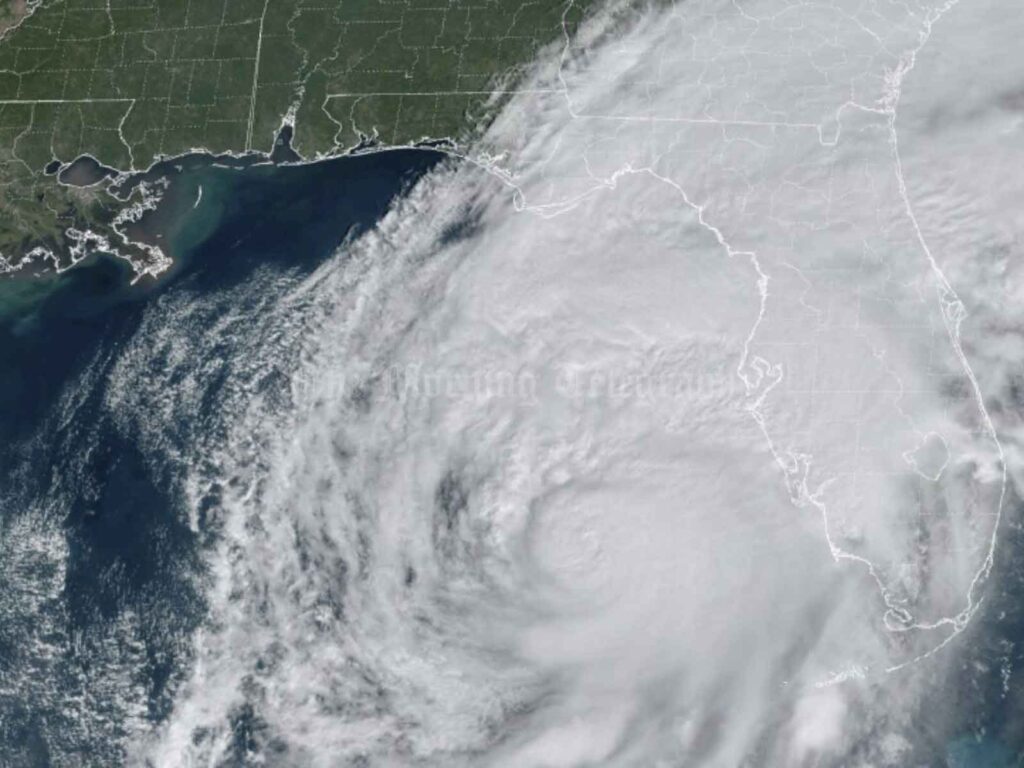
Hurricane Milton made landfall on Wednesday night in Siesta Key, near Sarasota, as a powerful Category 3 storm, bringing widespread devastation to Florida. With winds exceeding 100 mph (160 kph), the storm pummeled cities across the state, sparing Tampa from a direct hit but causing severe flooding in nearby areas like St. Petersburg, where more than 16 inches (41 cm) of rain fell. The National Weather Service issued warnings of flash floods in western and central Florida as the storm moved inland.
The impact of Hurricane Milton has been massive, with over 3 million homes and businesses left without power as of Thursday morning. Restoration efforts are expected to face significant delays due to the flooding and debris littering many roads. In St. Petersburg, a major water main break cut off household water supplies, while Tropicana Field, home to the Tampa Bay Rays baseball team, was heavily damaged. The stadium’s domed roof was torn apart by the storm’s fierce winds. Additionally, multiple cranes in the area toppled, contributing to the already considerable damage.
Before Milton even made landfall, several tornadoes swept through the state. The Spanish Lakes Country Club near Fort Pierce, located on Florida’s Atlantic Coast, was hit particularly hard, with numerous homes destroyed. Authorities confirmed that there had been fatalities, particularly in St. Lucie County, where homes were flattened. According to Kevin Guthrie, the director of the Florida Division of Emergency Management, approximately 125 homes were destroyed, many of them mobile homes in senior citizen communities.
In response to the storm, Governor Ron DeSantis deployed 9,000 National Guard members, along with 50,000 utility workers, to assist in recovery efforts. State highway patrol officers were also tasked with escorting fuel tankers to ensure gas supplies reached areas in need. During a press conference, DeSantis warned that fatalities were likely, acknowledging the severity of the situation and the risks posed to those who remained behind. Emergency services in some counties were suspended, as it was too dangerous for first responders to operate at the height of the storm.
Evacuation orders were issued across 15 counties, affecting over 7 million people. However, many residents faced challenges in leaving due to hotel shortages and gas station outages. Jackie Curnick, a resident of Sarasota, decided to stay behind with her family, unable to find affordable accommodations elsewhere. She expressed concerns about the difficulties of evacuating from a peninsula with limited road access, as they debated whether to stay or flee.
Although Tampa was spared the brunt of the storm, the surrounding area still experienced significant disruptions. Power outages plagued the region, and over 60% of gas stations in Tampa and St. Petersburg ran dry, despite efforts by state officials to replenish supplies. In the nearby Gulfport area, residents like Christian Burke chose to remain in their homes, built to withstand major storms, though they acknowledged the gravity of the situation as hurricane conditions intensified.
The storm also caused widespread disruption to air travel and tourism in Florida, with about 1,900 flights canceled, while popular theme parks such as Walt Disney World, Universal Orlando, and SeaWorld shut down for the day.
By Thursday morning, Hurricane Milton had been downgraded to a Category 1 storm, with winds of about 85 mph (135 kph). Though it weakened, the storm continues to pose a significant threat as it moves inland, particularly in the Orlando area, where heavy rainfall is expected to cause additional flooding before the storm eventually moves offshore into the Atlantic Ocean.
The storm’s arrival comes just two weeks after Hurricane Helene devastated western Florida, leaving 230 people dead across the southern U.S. In many coastal areas, efforts to clean up debris from Helene were still underway, and the double blow of Milton has left local officials scrambling to manage the compound effects of these two major storms.




